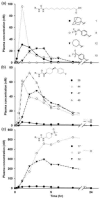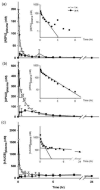Pharmacokinetic screening of soluble epoxide hydrolase inhibitors in dogs
- PMID: 20359531
- PMCID: PMC3285443
- DOI: 10.1016/j.ejps.2010.03.018
Pharmacokinetic screening of soluble epoxide hydrolase inhibitors in dogs
Abstract
Epoxyeicosatrienoic acids that have anti-hypertensive and anti-inflammatory properties are mainly metabolized by soluble epoxide hydrolase (sEH, EC 3.3.2.3). Therefore, sEH has emerged as a therapeutic target for treating various cardiovascular diseases and inflammatory pain. N,N'-Disubstituted ureas are potent sEH inhibitors in vitro. However, in vivo usage of early sEH inhibitors has been limited by their low bioavailability and poor physiochemical properties. Therefore, a group of highly potent compounds with more drug-like physiochemical properties were evaluated by monitoring their plasma profiles in dogs treated orally with sEH inhibitors. Urea compounds with an adamantyl or a 4-trifluoromethoxyphenyl group on one side and a piperidyl or a cyclohexyl ether group on the other side of the urea function showed pharmacokinetic profiles with high plasma concentrations and long half lives. In particular, the inhibitor trans-4-[4-(3-adamantan-1-yl-ureido)-cyclohexyloxy]-benzoic acid (t-AUCB) not only is very potent with good physiochemical properties, but also shows high oral bioavailability for doses ranging from 0.01 to 1mg/kg. This compound is also very potent against the sEH of several mammals, suggesting that t-AUCB will be an excellent tool to evaluate the biology of sEH in multiple animal models. Such compounds may also be a valuable lead for the development of veterinary therapeutics.
Copyright 2010 Elsevier B.V. All rights reserved.
Figures







Similar articles
-
Pharmacokinetic optimization of four soluble epoxide hydrolase inhibitors for use in a murine model of inflammation.Br J Pharmacol. 2009 Jan;156(2):284-96. doi: 10.1111/j.1476-5381.2008.00009.x. Epub 2009 Jan 13. Br J Pharmacol. 2009. PMID: 19154430 Free PMC article.
-
Peptidyl-urea based inhibitors of soluble epoxide hydrolases.Bioorg Med Chem Lett. 2006 Oct 15;16(20):5439-44. doi: 10.1016/j.bmcl.2006.07.073. Bioorg Med Chem Lett. 2006. PMID: 16908134 Free PMC article.
-
Orally bioavailable potent soluble epoxide hydrolase inhibitors.J Med Chem. 2007 Aug 9;50(16):3825-40. doi: 10.1021/jm070270t. Epub 2007 Jul 6. J Med Chem. 2007. PMID: 17616115 Free PMC article.
-
Meloxicam fails to augment the reno-protective effects of soluble epoxide hydrolase inhibition in streptozotocin-induced diabetic rats via increased 20-HETE levels.Prostaglandins Other Lipid Mediat. 2017 Sep;132:3-11. doi: 10.1016/j.prostaglandins.2016.08.004. Epub 2016 Sep 3. Prostaglandins Other Lipid Mediat. 2017. PMID: 27596333 Review.
-
Small Molecule Soluble Epoxide Hydrolase Inhibitors in Multitarget and Combination Therapies for Inflammation and Cancer.Molecules. 2020 Nov 24;25(23):5488. doi: 10.3390/molecules25235488. Molecules. 2020. PMID: 33255197 Free PMC article. Review.
Cited by
-
Incorporation of piperazino functionality into 1,3-disubstituted urea as the tertiary pharmacophore affording potent inhibitors of soluble epoxide hydrolase with improved pharmacokinetic properties.J Med Chem. 2010 Dec 9;53(23):8376-86. doi: 10.1021/jm101087u. Epub 2010 Nov 11. J Med Chem. 2010. PMID: 21070033 Free PMC article.
-
Epoxyeicosatrienoic acids enhance axonal growth in primary sensory and cortical neuronal cell cultures.J Neurochem. 2011 May;117(4):632-42. doi: 10.1111/j.1471-4159.2010.07139.x. Epub 2011 Jan 24. J Neurochem. 2011. PMID: 21155804 Free PMC article.
-
Epoxyeicosatrienoic acid-dependent cerebral vasodilation evoked by metabotropic glutamate receptor activation in vivo.Am J Physiol Heart Circ Physiol. 2011 Aug;301(2):H373-81. doi: 10.1152/ajpheart.00745.2010. Epub 2011 May 20. Am J Physiol Heart Circ Physiol. 2011. PMID: 21602473 Free PMC article.
-
The soluble epoxide hydrolase inhibitor TPPU alleviates Aβ-mediated neuroinflammatory responses in Drosophila melanogaster and cellular models of alzheimer's disease.J Inflamm (Lond). 2025 Jun 23;22(1):25. doi: 10.1186/s12950-025-00449-7. J Inflamm (Lond). 2025. PMID: 40551105 Free PMC article.
-
Effects of 17,18-Epoxyeicosatetraenoic Acid and 19,20-Epoxydocosapentaenoic Acid Combined with Soluble Epoxide Hydrolase Inhibitor t-TUCB on Brown Adipogenesis and Mitochondrial Respiration.Nutrients. 2025 Mar 7;17(6):936. doi: 10.3390/nu17060936. Nutrients. 2025. PMID: 40289939 Free PMC article.
References
-
- Borhan B, Mebrahtu T, Nazarian S, Kurth MJ, Hammock BD. Improved radiolabeled substrates for soluble epoxide hydrolase. Anal Biochem. 1995;231:188–200. - PubMed
-
- Chiamvimonvat N, Ho CM, Tsai HJ, Hammock BD. The soluble epoxide hydrolase as a pharmaceutical target for hypertension. J Cardiovasc Pharmacol. 2007;50:225–237. - PubMed
-
- Dingemanse J, Appel-Dingemanse S. Integrated pharmacokinetics and pharmacodynamics in drug development. Clin Pharmacokinet. 2007;46:713–737. - PubMed
Publication types
MeSH terms
Substances
Grants and funding
LinkOut - more resources
Full Text Sources
Other Literature Sources

